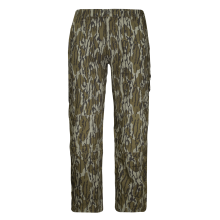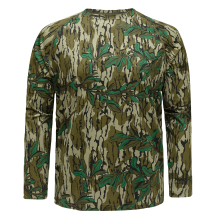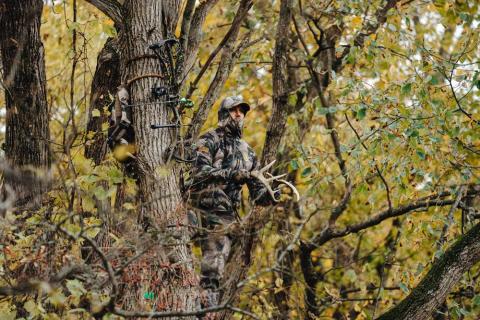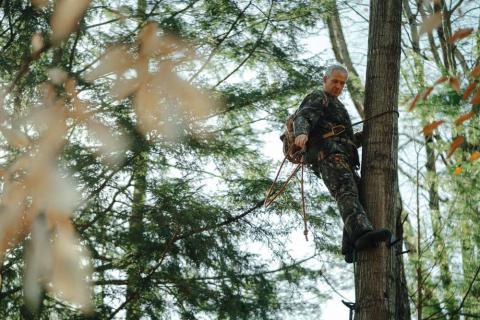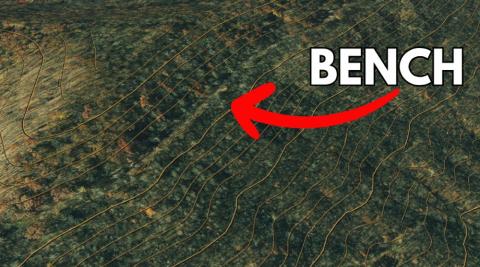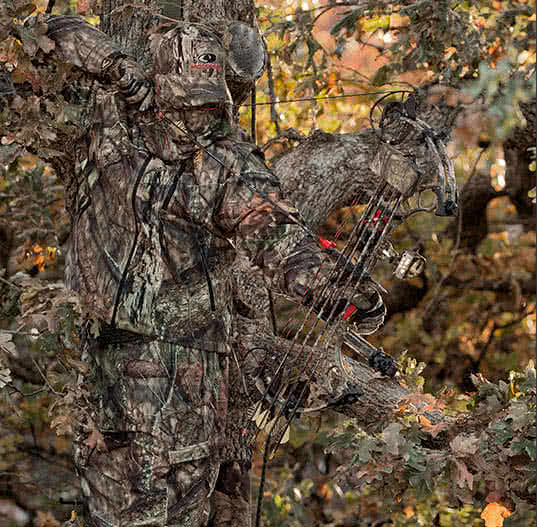
The author with a self-made 70" longbow backed with rattlesnake skin.
Butch Barnes
In a land far away (about 100 miles from my home in Tuscaloosa), in a time long ago (about 1951), a family that included a 5-year-old boy moved from Selma, Alabama 15 miles southwest to Orrville, Alabama. They would live in this little house until Christmas of his 4th grade year. During these five years, he would be introduced to television, with its heavy dose of cowboys, Indians, Tarzan, William Tell, Robin Hood, a subscription to Boy’s Life magazine, and a first cousin mentor named Raymond, who was 10 years his senior and lived just two miles away. These “influencers” would conspire to develop him into a lover of anything that involved a projectile: sling shots, bows and arrows, spears, slings, atlatls, trebuchets, and boomerangs. A few years later, he acquired a BB gun, and later still, rifle and shotgun. Due to parental oversight and their experience with this oldest son’s penchant for trouble, he got off to a slow start; whereas, he was a proponent of “I want it all, and I want it now”. Another contributor was financial: no money to purchase any of these. His solution? Make his own. However, those constraints could not last forever, and as he is now counting down to his 80th birthday in 2026, his love of these projectile-launchers remains as strong as ever. This is his story of making his own, with an emphasis on his lifelong passion for archery.
According to my maternal grandmother, (Yes, I am that elder son noted above) my first words were spoken when someone tried to demonstrate to me how to do something. She said my defiant response was, “Do it self!”, but that’s probably a stretch, maybe; I have no grounds on which to refute her story. There’s an old adage that claims, “Necessity is the mother of invention”. The necessity for my brothers and me was not so much about invention as it was creating – toys, games, and especially things that would launch projectiles. When we moved to the little house on the street corner in Orrville, Alabama, which is a small town 15 miles southwest of Selma, I was five years old. The house came with a little pasture of about an acre. The property was fenced around its perimeter, and it separated the small yard from the pasture. Just outside the back fence was a ditch – known as the “town ditch” – that ran from one end of Orrville to the other and carried heavy rainfall out of town to prevent flooding. Both sides of this ditch were covered by privet. One afternoon, as I wandered around the back fence – the parent-imposed outer limit of my wanderings – I discovered that some of the privet saplings appeared to be suitable for a bow – straight with no twigs for 4 or 5 feet - and some nearby switch cane could possibly be used for arrows. I would have to consult with my mentor. That opportunity arose a couple of weeks later when he and his family came by after church for lunch.
After lunch, I talked mentor Raymond into showing me how to make a bow and some arrows. He not only agreed, he accompanied me to the ditch, found a suitable privet sapling, pulled out his pocket knife, and cut it to a length of about three feet. He adamantly refused to allow me to cut the sapling. The following weekend, he returned with some fishing line, and after cutting a shallow groove around each end for the string, he presented me with my first bow. He returned later with four or five switch cane arrows tipped with empty bullet brass, and I was ready to take down anything from mice to elephants. Unfortunately, it didn’t take long for the little bow to weaken to the point of being useless. Decades later I would learn that privet was not on the list of preferable woods for bow making. After this shaky introduction to do-it-yourself archery, I decided to consult with my grandfather.
While visiting with him a few days later, I asked my for his advice about a better wood for a bow. He suggested hickory and told me where to find some saplings on his farm. He took the time to accompany me to the recommended area and even allowed me to cut one by myself. I also completed bow number two by myself, using an “Old Hickory” butcher knife absconded from Momma’s utensil drawer in the kitchen – secretly, of course. I was also longing for some “real” arrows like the Indians on TV used, but such was not to be. However, the switch cane shafts with a few small chicken feathers tied below the nock proved to be serviceable.
After losing or breaking all my switch cane arrows, I decided to move along to my next “projectile launcher” – sling shots - Raymond had acquired a punctured red rubber innertube and had agreed to cut into strips to make sling shots. This red innertube rubber was said to shoot faster and was tougher than black ones, and it proved to be so. I made a double-stripper with forked grip for myself and a single stripper “flip” for my brother “Shot”. We placed English sparrows, starlings, mice, and rats on our most-wanted list, and entertained ourselves pursuing them as one of our favorite summer and weekend pastimes.

Meanwhile, the cowboys on TV were dominating the Indians, and I felt the urge to switch sides and be the Indian in our war games. By now I was obsessed with archery. But before I could make that properly-armed transition to the Indian side, it was time for our family to move again – during Christmas holidays of my 4th grade year. This time it was all the way to the east side of Dallas County to a small town named Burnsville. This move would be our parent’s nineth house since they married in 1944 – a period of just 7 years. I sensed that this move was probably based on financial problems. Daddy had left Henry Brick Co. and got into the logging business. Momma must have told him how disappointed I was in having to change schools, and he came home one afternoon soon after the move with a used commercially-produced hickory bow – my first “real” bow. It was probably a Ben Pearson model made for Boy Scouts. With my brothers “Shot” and Larry having no bow, I made one for each of them from hickory saplings from the woods behind the house, but they were not thrilled with the comparison to mine. Besides, they wanted to remain cowboys, while I would remain the powerful and crafty Indian opposition. There is a photo somewhere of the three of us just before the two of them reverted back to cowboys. The three of us are standing side by side with bows at full draw. However, a close examination reveals that Larry’s “bow” was the end of a broken broom handle with neither string nor arrow. Momma wanted to take the photo of her three archers, and Larry’s bow was nowhere to be found. He has never forgiven me for that photo. He and Shot quickly reverted back to cap pistols.
Shortly before we moved to Burnsville from Orrville, cousin Raymond had purchased a solid fiberglass longbow, and I longed for one of my own. I was amazed by the distance it could cast an arrow. By this time, however, I knew owning one wasn’t in the cards. Our brief one-year stay at Burnsville would be one of sacrifice and unfulfilled wishes. In the middle of my 5th grade year, we moved back to Orrville into what was known as the “Wooly house” – named for its owner. It was a hundred yards down the road from cousin Raymond and his family, and across the road was my maternal grandparents’ farm. With woods and my mentor close by, it was time to get serious about anything that would launch projectiles, and they would have to be homemade out of necessity. At this time, sling shots were our primary launchers. Forked sticks were plentiful; string was available on every sack of flour as well as from my grandfather’s feed bags. As for ammo, it was free for the taking on the gravel bars on nearby Tatum Creek.
However, while still at the Wooly house, I was surprised one evening when Daddy came home with a crossbow for me. It was factory-made from a single hardwood board, a spring-metal allow bow, a thin steel cable for the string, but only three “bolts”, the short, thick arrows used in crossbows. It had a 40-pound pull, and despite its power, it wasn’t very accurate. Besides, American Indians never had crossbows. My yearning for a real hunting bow like those on TV was ever present in the back of my mind. Over the next few years until I graduated from high school – five years and four more moves – I put my archery cravings on the shelf, as my interests turned to cars, and beginning in the summer before the tenth grade, working each summer. I would have to wait several years until I graduated from college in March, 1969. For that accomplishment, my oldest sister Dorothy, who had graduated two years earlier, surprised me with a brand-new beautiful Shakespeare Wonderbow recurve and six fiberglass arrows. I was amazed by its beauty and accuracy. After a couple of weeks of practicing afternoons after work, I was able to consistently hit a 3” circle at 20 yards. But hunting with it would have to wait.
For the two years following college graduation, I was training for a management position with USDA and traveling all over the state, and I met my soulmate and got married. For the record, the wait was well worth it. In February of 1971, my wife and I moved to Mobile, where I had been selected to be the manager of the USDA office for Mobile County. After three years in Mobile – and the addition to our family of a son and daughter – the same position opened in Wilcox County, and we were on the move again. While I thoroughly enjoyed our stay in Camden – it is a hunter and fisherman paradise - my same position opened in Monroe County, the adjoining county on the south side of Wilcox – again three years later, and it too is another sportsman’s paradise, and I was chosen for the position. Both moves also involved a promotion and salary increase. So after three years in Wilcox County, we were moving again, but this time, our stay would be a little longer – 36 years to be exact. My passion for archery was finally fulfilled.
But backing up a moment to the 1960’s, and unbeknownst to me, a new approach to archery was being developed and tested by Holles Wilbur Allen, and in 1969 he patented his invention – the compound bow – which forever changed archery. In the years following, there were rapid improvements to this original design by a growing number of manufacturers, and archers would see unprecedented increases in arrow speed, decreases in draw weight, and consequently, a huge increase in shooting and hunting archery participants.

Forwarding back to the 70’s, my son Michael was five years old when we moved to Monroeville in 1976. Like me, he exhibited an early interest in archery. After providing him with a little fiberglass bow and size-matching arrows, he appeared to be a natural. I made a target of a burlap bag packed with pine straw and painted a 3” black circle on it for a bull’s eye. After a few weeks of practice, I watched one afternoon as he shot 4 consecutive arrows from 20 feet into the circle. We recorded it with a photo of Him standing beside his accomplishment. Fifteen years later, I took another picture of him standing beside a different target – a 350 lb. boar he killed with a compound bow. Yes, he and I had succumbed to the compound craze.
The invention of the compound bow had a huge impact on interest in bowhunting for deer. Both Michael and I had become enamored with their power and arrow speed, not to mention accuracy when compared to traditional bows. My first one was a Browning Cobra. It had a 50# pull, and it resembled a traditional recurve bow with the recurves cut off and small wheels inserted into slots in both ends. It bore no resemblance to today’s sophisticated arrow-launching machines. I would take my first archery-killed deer with it in the late 70’s. I will never forget the emotions I felt watching that deer flee across the field and crash just before reaching the woods. I finally knew what the Indian hunters must have felt under these same circumstances.
Today’s models have little resemblance to that Browning Cobra. However, I have an old friend in Monroeville who still has his Browning Cobra from that same time with a 60# pull, and he killed an elk with it a few years ago. This was long after the evolution to far more complex models with ever-decreasing let-off and ever-increasing arrow speed, as well the addition of adjustable sights. I have to confess here that I was drawn into this craze for speed and accuracy, along with millions more. By about 2010 I had killed over thirty deer with a compound bow, and I was like many others, still chasing after the latest and greatest in innovation. My last compound was also a Browning model, and I was very successful with it, due primarily to my not taking shots over 20 yards. It now resides with my youngest grandson.
But sometime during this technology boom, a new “movement” arose – a yearning by many hunters to return to a simpler time and simpler equipment. It was a call I couldn’t resist. We had moved in 1997 about a mile from our first house in Monroeville to a larger one with a larger yard. Shortly after the move, I added a shop in the back yard and prepared to chase my long-delayed “do-it-self” dream. Little did I know how fulfilling that “hobby” would become in the years ahead. I had found an incredible Osage orange tree on my in-laws’ farm in Sumter County. The day we cut it over the Christmas holidays would be remembered decades later as a significant event. My father-in-law, my son Michael and his wife-to-be, and I – three generations – were there for the cutting. I didn’t realize the significance of this until years later after all the staves were given away or made into bows, and I was reminiscing about those “good old days”. Based on its growth rings, my perfect tree was 38 years old, and it produced two perfect 7-foot logs that were a bow-maker’s dream. They had been drying for about three years when we moved to our second Monroeville home, and I had been studying a book by Jim Hamm titled, “Bows and Arrows of the Native American Indians”. Once the shop was finished, I dove into bow-making with a renewed passion. This hobby would also serve as a therapeutic activity and stress relief from my job at the Alabama River Pulp Mill.

During the height of this “revival” – a return by many to the traditional archery of old – some beautiful and functional traditional bows were turned out by true craftsmen. Most of those custom bows are best defined as “works of art”. I still have a Browning recurve, a custom Check-mate “Longhorn” made in Canada, and my son has a custom longbow from this era that I gave him years ago. We were privileged to meet the maker of this bow at a swap meet at Tannehill State Park. We were fortunate that this elderly gentleman was able to share the story of this bow: the elm tree from which it was made, his inspiration for the unique grip on this particular bow, as well as its “birth date”. That grip was the feature that my son really liked.
As I dove into this most rewarding hobby, I first had to procure the necessary tools. I already had a couple of antique draw knives, a chain saw, splitting maul and ax (we had a wood-burning fireplace), and hatchet. After purchasing a double-sided rasp (course/fine), rattail file, and planer, I finally began the process of making my first Osage bow. Those years of waiting for the staves to dry had crawled by at a snail’s pace. The target Saturday in late June finally arrived, and I decided to start on one of the short staves and get a good feel for how the wood “worked”. I first split all 8 staves into two each and used the two short ones for my first attempts. The first one came from the inside half of one of the two short staves. I wanted to get as many bows as possible out of each stave.
Following Jim Hamm’s meticulous instructions, I whittled away on the first little stave, and that first bow exceeded my highest expectations. I added deer antler slivers to the front side of the tips as reinforcements for the string nocks, a sliver of antler to the front side of the grip, and two short strings of colored beads below it. I added these extras because it was a gift to a young boy who had a strong interest in archery, but had no bow. I also included a handmade deerskin quiver from the hide of a deer he had killed, and to really personalize it, I used the section of the deer hide that included the bullet hole. He was elated! Soon after completing his bow, I made another one from a split off the back of the other short stave for a fellow worker at the pulp mill where I was employed. He was left-handed, and I had noted that this split-off stave had a curve in the growth ring exactly where the arrow rest would be for a left-hander, and it turned out just as I hoped. He named this bow “Ehud”, an old testament Israeli judge, and this name means “left-handed assassin”.
In the fall of 1997, I started on my 58” flatbow. It also exceeded my expectations, primarily because I took my time and took no shortcuts – often difficult traits for me to embrace. I left two additional growth rings on the back center of the grip about 8” long. This allowed me to cut finger grooves for gripping the bow consistently in the same place, which improves accuracy but doesn’t cut into the backside growth ring. As is the tradition for self-bow makers, I named this one and wrote it on the inside of the top limb at its widest point. Its name – Esau – is after Isaac’s first son (see Genesis 25), who grew up to be an excellent hunter. I had lofty aspirations.
Over the next couple of years, I donated some staves to friends who wanted to make one for themselves or their sons, made a few for friends, and made a bow to donate to a silent auction at an Alabama Wildlife Federation wild game supper. Including those first two short ones noted above, that tree produced 20 bows, and three stave recipients were able to get two bows from the one stave I gave each of them. One of these was a fellow employee, and the two he made were exceptional. The one for himself was a 72” longbow with a round belly, and the other – for his son - was a beautiful recurve backed with rattlesnake skins. I had earlier given a stave to a friend of his - a young man who was attending a hunter safety course (I was one of the instructors) so he could go on an elk hunt in Colorado. He began working on his bow soon after the last class ended, then took it with him to Colorado to finish on the elk hunt. When he returned, he brought the bow by to show me his work of art that he had finished around the campfire each night on the hunt. It was a beautiful 72” longbow with a 65lb. pull. As I felt the glass-smooth finish and admired his great craftmanship, I noticed this inscription just above the grip on the inside of the bow: “A gift from God”. That stave had found a good home, and he would use it that deer season to kill five deer. Other stave recipients would also come to show theirs or send me a photo.
While I enjoyed many trips with friends, my son, and grandsons to hunt or just shoot arrows at random targets, there was an afternoon spent with four junior high boys from church that was really special. None of the them were outdoorsmen, but were active in team sports. I was their teacher in their Sunday evening youth fellowship class, and I asked them after a class if they would like a trip to the north end of Monroe County to a wilderness area. They accepted the invite and sounded excited about the adventure – a first for them. I didn’t tell them what I had planned for them.
The following Sunday, we headed north from the church, and they began questioning me about what we would be doing. I told them they would have to wait and see. I had gone to our destination earlier in the week and found exactly what I wanted to start their adventure. The target area was a large tract of timber on the Alabama River managed by the U.S Army Corp of Engineers for public use. At the time of this adventure, it had been many decades since any timber had been harvested. The hilly landscape was covered with old growth hardwoods and pines, relatively clean understory, and numerous muscadine vines, many growing from the ground to the upper canopy of one of those tall trees. One of these was my target, and I found the perfect one.
The thick vine had grown from the bottom of a “draw” with a long slope up to a ridge on both sides. I cut it about two feet above the ground and notched it on one side about 6” above the end. I found a nearby dogwood and cut a 2” thick limb about a foot long and tied it in the notch with wire. This would serve as a foot-hold. I added a second one for a hand-hold about five feet above the other one, and it was ready – except: it was essential that I test it for safety. I had grown up making these “swings” and was pretty sure the tangle of vines from the main one into the top of a towering white oak would hold without slippage. I snatched downward on the vine several times, and nothing budged. Next, I backed up the hill behind me to the limit of where the “takeoff point” would be, grasped the handhold, jumped onto the footholds, and away I went! It was an exhilarating trip! The offshoot vines held without any slipping, and since I was heavier than each of the boys, I felt there was no danger of the vine giving way.
When we arrived at our starting point, they didn’t see anything out of the ordinary – until I pointed out the vine. Almost in unison: “We’re going to swing on that?” To calm their concern, I agreed to demonstrate. When I swung out across the draw below and back to the starting point, I thought they were going to fight to determine who was next. The swinging probably lasted an hour, but I didn’t want their hands to get too tired for our next activity.
Old school traditional archers call it “stump shooting”. We called it big game hunting. I had brought five bows and twenty field arrows – enough for four each. The objective – taking turns – was to pick out a target such as a large tulip tree leaf, rotten stump, or large pine cone in a location with a backstop. I didn’t want to lose any arrows. The shooter then assigned it a creature’s name – deer, alligator, dinosaur – whatever he imagined – and he took the first shot., followed by the others. This started out being pretty difficult, but after about thirty minutes and my shooting instructions, they started getting the hang of it. A hit brought five shouts of success, as well as groans following misses. Two gallons of gas and four hours of my time had bought an experience for four young boys that can best be described as priceless. On our drive back to Monroeville, after several minutes of silence from the four of them, I wondered what was on their minds. One of them broke the silence with, “That was the most fun I ever had in my life.” It was followed by three earnest confirmations, as they began naming their favorite experiences. I have often wondered if any of them took up archery later in life.
I would make my last bow in 2001, 4 years after finishing the 58” flatbow. It is a 70” longbow backed with two matching timber rattler skins. Its initial draw weight was 65 pounds at a 26” draw. I would later shave off some wood from its belly, reducing the draw weight to 57 pounds. I was now dealing with arthritic shoulders and decided my bow-shooting days were over. However, I filled that void by making custom tube-type turkey calls using exotic hardwoods, with a hand-painted bust of a turkey on it. However, in 2024 following my 79th birthday, I decided it was time to drop this hobby also. A minor stroke that affected by left hand made it too risky to use power equipment. The former good eyes and steady hand aren’t what they used to be. My latest – and last – venture is writing, documenting the colorful life and times of a poor, white, red-neck baby boomer in Alabama’s Blackbelt. Its title is “Makin’ Do”. I’m finally putting that English major to use, and it’s been quite a journey. The bow-making experience was very rewarding, especially when I gave them to youngsters, or a stave to their dads to make a bow for their sons. It reminded me of my own youth and the thrill I got when my dad gave me that old used hickory bow when I was nine years old. Today, as I think back to those bow-making years, some of them have probably been passed down to one or two more generations of the owners’ families. And today, in the year 2025, over three decades after finding that remarkable Osage orange tree, I realize that this tree - in every sense of the phrase - was truly a “tree for the ages”.














